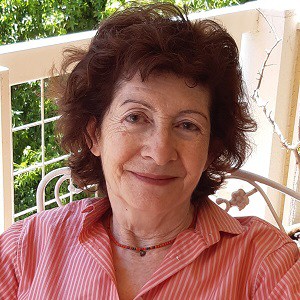Eirini Avramopoulou
Assistant Professor at Panteion University. AREAS OF INTEREST: Anthropology of Human Rights and Activism, Legal and Political Anthropology, Gender and Sexuality, Affect and Emotions, Politics of Space. |
Anna Gibbs
Professor in the School of Humanities and Communication Arts at UWS, and member of the Writing and Society Research Centre and the Digital Humanities Research Group. |
Elizabeth Sakellaridou
Professor of drama and theatre studies in the Department of English of Aristotle University, Thessaloniki, Greece. She also lectures at the Department of Theatre Studies. |
Gregory J. Seigworth
Professor of Communication Studies in the Department of Communication and Theatre. He has published widely in journals such as Cultural Studies, Architectural Design, Culture Machine, and m/c. Greg has contributed chapters to various books, including Deleuze: Key Concepts, Animations of Deleuze and Guattari, and New Cultural Studies. |
Abstracts
Burning issues, burned subjects: Cruel temporalities in the
field of gender-based violence
Eirini Avramopoulou, Panteion University
Çow do particular forms of knowledge turn into urgent matters and thus mediate the (im)possibility of making sense of the gendered effects of violence? Drawing on the development of critical engagement with discourse, identity, and representation through affect theory, since the 1990s, my presentation focuses on the affective circulation of knowledge about gender-based violence and interrogates the effects of injurious stereotypes reiterated in the name of acting against violence. At the same time, relying on interviews conducted with lawyers, psychologists, activists and caretakers that reveal feelings of anger, exhaustion, self-annulment and disempowerment due to a 'caring economy' devoid of the necessary infrastructures, and taking into consideration that being exposed to GBV entails being exposed to feelings of pain, fear, guilt, remorse, anger, mourning, lost self-esteem, I also ask: How does knowledge about violence reproduce the effects of violence aiming to combat and thus 'burns out' those involved in this field? Or else, what makes GBV so resilient despite the actual "noise" that knowledge about it makes? By asking these questions, my argument is that this context begs for possible answers beyond the frame of a carceral feminist perspective or a legal feminist rhetoric that try to find "the right ways" to re-write laws, restructure policy-making, policing and prison systems in order to "secure better lives" for those exposed to the effects of male violence. Instead, it forces us to consider such issues from a social justice perspective (rather than a criminal justice one), and interrogate the cruel temporalities at work when the urgency of action and its biopolitical effects might also "burn" the possibility to demand social justice differently.
Catchy: cryptic spread and the dynamics of contagion
Anna Gibbs, School of Humanities and Communication Arts at
UWS
According to epidemiologists, cryptic spread occurs when there
are hidden or cryptic connections in viral transmission either
between or within species. This makes for transmission events that
are hard both to qualify and quantify, often imperceptible and
difficult to identify.
This paper examines some of the intricately enmeshed biological,
social and mediated viral dynamics around the three+ years of the
ongoing SARS-Cov-2 pandemic, discussing the way cryptic spread
occurs through rhythmic relays in mobile and constantly changing
circuitries of affect, ideas, images and human, automated and viral
actions and behaviours. Crucially, not all actors are equal in these
processes, nor in the affectively-driven mimetic relations that
largely enable them as they generate ‘affective atmospheres’, making
palpable connections between people and things that seemed
unrelated. There’s something in the air. Turbulence can make it hard
to track and, as in weather systems, things can stall, settling in
to a particular pattern or a given mood until pressure shifts and
conditions change.
The Kinesthetic Possibilities of Art: Processes and
Reconfigurations
Elizabeth Sakellaridou, Aristotle University of Thessaloniki
As a person with a ceaseless passion for the arts, especially the performing arts, I want to see the present, so-called “post-Covid” moment as a celebration of our return to communal life in physical terms: an impulse to move, to go out, to congregate and interconnect not through digital mediation but through the living, the moving body. Essentially therefore, my talk will be about the recovery of the body and its kinesthetic possibilities in the production and reception of art. My approach will be mainly phenomenological. The term “kinesthesia” has been used since the late 19th century in order to express sensations of movement – self-movement at first and later the movement of others. For this latter human activity the term “empathy” was introduced in the beginning of the 20th century. As a variation of this, “kinesthetic sympathy” was used in the 1930s to explore the expressive and affective possibilities of dance. For my e-motional journey into art I have chosen five examples from five different, though often intersecting, art forms: sculpture, video installation, jazz performance, street performance and theatre performance indoors and outdoors. My examples are all accounts of my embodied experience here and abroad and their brief analysis will aim at substantiating my argument that especially the performance arts, despite all the facilities offered them by digital and intermedial technology, can only be perceived along the full spectrum of mobility, sensation and emotion if they remain an integral part of the physical world where bodies move and are moved interchangeably.
All that is solid melts into aerial karate: environmentality
and infinitesimal forces in motion
Gregory J. Seigworth, Millersville University
This talk will begin with a particular example drawn from contemporary predictive data analytics to address an issue that Michel Foucault raised briefly about ‘environmentality’ toward the end of his 1978-79 seminar on The Birth of Biopolitics. Foucault sees – in a futural glimpse of where biopolitics is already heading -- that “the technology to be employed is not discipline-normalization, but action on the environment ... modifying the terms of the game, not the players’ mentality.” I will explore how we might understand this whole field modulation of bodies-in-motion as a chief aim of predictive analytics, along the way touching on Leibniz’ theory of ‘petites perceptions,’ the aggregate forces that form the banal non-conscious, and those miniscule intensities that persistently nudge at the imperceptible edges of bodies & populations.

